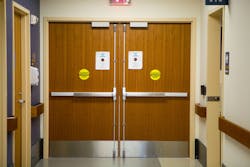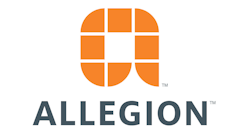When designing an access control system, it can be difficult to factor in all the code requirements that could impact the security plan. In some cases, the need for security and the rules for life safety conflict, but typically, the adopted codes and standards are mandatory legal requirements. With proper system design, the codes can be met without jeopardizing security.
Many access control systems include doors with panic hardware, to enable large numbers of people to exit quickly in an emergency. The required locations for panic hardware vary depending on which code has been adopted, but typically, panic hardware is required for assembly, educational/daycare, and high hazard occupancies, where the calculated occupant load is 50 people or more (International Building Code (IBC) and International Fire Code (IFC)); or 100 people or more (NFPA 101 – Life Safety Code). Panic hardware is also mandated by NFPA 70 – the National Electrical Code, for doors serving some rooms containing electrical equipment.
With a few exceptions, when a door is part of a means of egress from one of these use groups AND the area exceeds the stated occupant load, the door can only have a lock or latch if it is panic hardware.
For each type of electrified panic hardware used in an access control system, there are code requirements that must be considered to ensure that along with controlling access and addressing security, the system enables building occupants to exit safely.
When considering which code requirements to follow, first identify which category the hardware falls into, and refer to the applicable sections in the adopted code publications for specifics. This summary is not intended to provide complete information about each of the types of electrified hardware referenced; in fact, state or local requirements may differ from those of the IBC or NFPA 101, so it is important to be aware of the adopted codes in the project’s jurisdiction.
Finally, when specifying or supplying access control hardware, keep in mind the layered requirements for egress, fire protection, and accessibility – including those that apply to panic hardware.
Controlled Access and Free Egress
The most common type of access control system has an access control reader on the ingress side of the opening to control access, with unrestricted egress. Pushing the touchpad of the panic hardware or turning a lever handle allows immediate egress, regardless of the status of the access control system.
When these systems include panic hardware, access control is usually accomplished with electrified lever trim or electric latch retraction, although these systems may also include electric strikes or electromechanical locks – all allowing free egress via the mechanical hardware.
There is not a specific section in the model codes addressing this type of access control system; however, this hardware must comply with the typical code requirements for operable hardware. Doors must be unlatched with one releasing operation and readily openable from the egress side without a key, tool, special knowledge or effort. Hardware must be operable without tight grasping, tight pinching, or twisting of the wrist, and releasing hardware must be mounted between 34 inches and 48 inches above the floor.
Other access control applications that do not allow immediate egress will typically fall into one of the other categories – sometimes called “special locking arrangements” as outlined below.
Controlled Egress in Healthcare
The controlled egress application is allowed only in limited locations in healthcare occupancies; in fact, this system cannot be used in other types of facilities. The area must be one in which patients require containment for their safety or security, such as a memory care unit which houses patients with dementia. The Authority Having Jurisdiction (AHJ) is responsible for approving the types of healthcare units where controlled egress may be used, but pediatric and maternity units, and emergency rooms are common locations.
Controlled egress systems are allowed by code to prevent people from exiting if certain criteria are met. The most common locks used in these systems are electromagnetic locks, or delayed egress panic hardware which has been modified to have an “infinite delay” instead of the typical 15-second delay. In either case, the hardware must be fail-safe, so it enables immediate egress when power is removed.
In healthcare facilities where controlled egress systems are installed, all clinical staff members are required to carry keys, codes, or other credentials required for egress. With the exception of behavioral health units and areas with infant-abduction systems, the lock must automatically unlock to allow egress upon actuation of the fire alarm or sprinkler system; upon power failure; and by actuation of a remote switch. There are additional requirements for these systems in both the IBC and NFPA 101, which vary slightly.
Delayed Egress Locks
When access control is needed in the direction of egress, it is not typically code-compliant for the doors to remain locked until the fire alarm is actuated, and then allow egress. The exception would be the controlled egress application described previously; however, there are situations where a door that is required for egress should not be used under normal circumstances – for example, many emergency exits serving large retail stores require hardware that deters theft and goes beyond a simple alarm.
A delayed egress locking system may include panic hardware or an electromagnetic lock with delayed egress circuitry, or a delayed egress controller used in combination with other listed components. Egress is delayed for 15 seconds (or 30 seconds where approved by the AHJ) but must allow immediate egress (no delay) upon activation of the required fire alarm/sprinkler system and upon loss of power.
Under normal operation, an attempt to exit will initiate the 15-second timer. An audible alarm will sound in the vicinity of the door, and 15 seconds later, the door will unlock and be available for egress. Signage is required on the door, as well as capability of remote release and emergency lighting. The codes also include limitations on the number of delayed egress locks that a building occupant must pass through as they traverse the means of egress.
Each of the model codes include different limitations on the occupancy classifications where delayed egress locks are allowed. For example, the IBC does not typically allow delayed egress locks in assembly, educational or high-hazard use groups. Two exceptions were added to the 2018 IBC, which allow delayed egress locks for secondary exits in courtrooms (assembly), and for classrooms with an occupant load of less than 50 people (educational). NFPA 101 includes limitations specific to the occupancy classification of the building or area served by the door.
Electromagnetic Locks
The model codes include separate sections related to electromagnetic locks, depending on the method of release – either of these systems could include panic hardware. The option that has been addressed in the codes for many years was originally titled “Access-Controlled Egress Doors.” Despite the title, which has now been changed to avoid confusion, these code requirements do not apply to every door with an access control system. They address locks released by a sensor that detects an approaching occupant and unlocks the door for egress.
Locks in sensor-release systems are also required to be unlocked by an auxiliary push button, actuation of the fire alarm or sprinkler system (if present), and power failure.
The other option is for electromagnetic locks to be released by a switch in the door-mounted hardware, such as a request-to-exit (RX or REX) switch in a lockset or panic device, or an electronic touch sensor. Unlike the requirements for a sensor-release system, the auxiliary push button and fire alarm release are not required for maglocks released by door-mounted hardware. With both the sensor release and the door-hardware release, the codes mandate the occupancy types where the systems are allowed.
Stairwells and Elevator Lobbies
Panic hardware is sometimes used on doors with access control which serve stairwells and elevator lobbies. In both cases, these openings would normally have hardware with fail safe electrified lever trim. Fail safe electromechanical locks and electromagnetic locks are also common in these systems. As stairwell doors are typically fire doors, electric strikes are not usually an option because electric strikes on fire door assemblies must be fail secure, and hardware used for stairwell re-entry is typically fail safe.
On stairwell doors, the purpose of the electrified trim is to allow building occupants to leave a stairwell during a fire and find another exit if the stair becomes compromised by smoke, and to allow firefighter access. NFPA 101 includes a section specific to elevator lobbies which allows a building occupant to exit from the lobby through a tenant space, but the IBC does not include a similar section.
Lori Greene, DAHC/CDC, FDAI, CCPR, is manager of codes and resources for Allegion. She can be reached via her website, http://iDigHardware.com. Request more info about Allegion at www.securityinfowatch.com/11248017.



